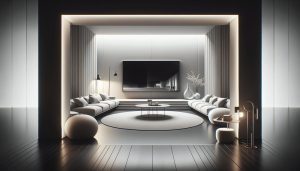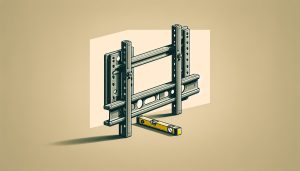Have you ever wondered about the best way to display your TV while maximizing room space? Mounting your TV on the wall can be a sleek and practical solution. This approach not only gives your living room, bedroom, or entertainment area a modern look but also enhances your viewing experience. However, with various wall mounting options available, making a decision can be a daunting task. In this guide, you’ll find a wealth of information about TV wall mounting options, making it easier to select the perfect setup for your needs.
Why Consider Wall Mounting Your TV?
Wall mounting TVs has become highly popular, and it’s easy to see why. Choosing this option can enhance your space aesthetically, deliver a superior viewing angle, and contribute to overall safety by keeping TV sets out of reach of pets or children. Understanding these benefits helps you weigh if it’s the right choice for you.
Aesthetic Appeal
Mounting your TV lets you achieve a clean, uncluttered look in your space. Flat-screen TVs are designed to provide a sleek and elegant appearance when mounted on a wall. This setup often reduces the need for bulky furniture to hold the TV, creating a more spacious feel in the room.
Enhanced Viewing Experience
By wall mounting your TV, you can position it at the perfect height and angle for viewing comfort. This flexibility allows you to watch your favorite shows and movies without straining your neck or eyes. Whether you’re lying back on the couch or sitting upright, a properly mounted TV provides an optimal visual experience.
Increased Safety
Accidents happen, especially in homes with active kids or pets. By mounting your TV securely on a wall, you can prevent it from being knocked over, reducing the risk of accidents and damage. Moreover, this arrangement keeps cables and wires neatly out of the way, minimizing tripping hazards.
Types of TV Wall Mounts
Choosing the right wall mount is a key factor in ensuring your TV is both secure and optimally positioned. Each type of mount has its own set of benefits and is suitable for different situations. Let’s walk through the different types, so you can determine which is best for your scenario.
Fixed Wall Mounts
Fixed wall mounts, also known as low-profile mounts or flat mounts, secure your TV closely to the wall. They provide minimal projection and are ideal if you have a dedicated room exclusively for TV watching. Fixed mounts don’t allow for any movement or tilting, making them best for spaces where glare isn’t a concern and the viewing angle is consistent.
Pros:
- Low cost
- Simple installation
- Slim profile
Cons:
- No angle adjustment
- Inconvenient for accessing cables
Tilting Wall Mounts
Offering more flexibility than fixed mounts, tilting wall mounts allow you to angle your TV vertically. This type is particularly useful if you need to place your TV higher on the wall, like above a fireplace, and want to adjust the viewing angle downwards. Tilt mounts usually extend slightly further from the wall to accommodate the tilting mechanism.
Pros:
- Adjusts for glare reduction
- Easier cable access than fixed mounts
Cons:
- Slightly more expensive than fixed mounts
- Limited horizontal adjustment
Full-Motion Wall Mounts
For the ultimate in flexibility, full-motion wall mounts—or articulated mounts—are the way to go. They allow your TV to be extended away from the wall, swiveled, tilted, and rotated. This flexibility means you can direct the TV to face different parts of the room, making it perfect for open-concept spaces or rooms with multiple seating areas.
Pros:
- Maximum adjustability
- Ideal for corner installations
Cons:
- Higher cost
- More complex installation
Ceiling Mounts
Ceiling mounts provide a unique solution when traditional wall-mounting isn’t practical, such as in rooms with limited wall space or for commercial settings. These mounts affix to the ceiling and can often be tilted, swiveled, or rotated for flexibility in viewing angles.
Pros:
- Utilizes otherwise unused space
- Wide viewing angle options
Cons:
- May require professional installation
- Potentially intrusive in aesthetic
Considerations Before Choosing a Mount
Before selecting a wall mount, there are several factors you need to consider to ensure your chosen option will meet your needs efficiently and effectively. This step is crucial for aligning both your preference and practical requirements.
TV Size and Weight
Every wall mount is rated for specific TV sizes and weights, so ensure the mount you choose can support your TV’s specifications. It’s vital to check your TV’s manual or the manufacturer’s website for its dimensions and weight before making a purchase.
Wall Material
Understanding your wall type is essential for a successful installation. Most mounts require you to drill into studs, which are the most secure option for holding the weight of a TV. For homes with brick, concrete, or drywall walls, the correct anchors and tools are necessary.
Viewing Distance and Height
Determining the best height and distance for mounting your TV greatly influences comfort and picture quality. A rule of thumb is that the center of the screen should be at eye level when seated. You’ll also want to measure the distance from the seating area to ensure it’s conducive to your TV size.
Cable Management
A well-mounted TV isn’t only about the position; it’s also about managing cables for a clean look. Planning for cable routing, using cable covers, or even in-wall cable management systems can make a huge difference aesthetically and functionally.
DIY vs. Professional Installation
Once you’ve selected the perfect mount, the next decision is whether to install it yourself or hire a professional. Each choice comes with its advantages and considerations which might play a role in your final setup.
DIY Installation
If you’re handy and enjoy working on home improvement projects, you might consider installing the TV mount yourself. You’ll need basic tools, a stud finder, a level, and patience. This route can provide a sense of satisfaction and save costs but requires time and precision.
Advantages:
- Cost-saving
- Flexible scheduling
Disadvantages:
- Risk of incorrect installation
- Time-consuming
Professional Installation
Opting for a professional installation means entrusting your project to an experienced technician. This option can ensure accuracy and avoid potential mishaps. It’s particularly recommended for complicated installations or unique wall materials where expertise is required.
Advantages:
- Guaranteed precision
- Saves time and effort
Disadvantages:
- Additional cost
- Scheduling constraints
Understanding the Tools and Equipment Needed
When preparing to mount a TV – whether doing it yourself or overseeing a professional – it helps to know what tools and equipment are typically needed for the best outcome. This preparation ensures the process runs smoothly.
Essential Tools
| Tool | Purpose |
|---|---|
| Drill | To make holes for mounting brackets |
| Stud Finder | Locates wall studs for secure TV placement |
| Level | Ensures TV mount is straight |
| Tape Measure | Helps position the mount correctly |
| Screwdriver | Secures screws into the wall mount and TV |
| Wrench | Tightens nuts and bolts on mounts |
Additional Accessories
You might also consider investing in some accessories that can enhance your setup or simplify the installation process.
-
Cable Management Kits: These help keep cords organized and mostly hidden from view.
-
Surge Protectors: Protect your TV from electrical surges that could cause damage.
-
Sound Bars or Speakers: Enhance audio quality, sometimes mounted alongside the TV.
Maintenance and Tips for Wall Mounted TVs
It’s essential to maintain and regularly check your wall-mounted TV for safety and optimal performance. Maintenance doesn’t have to be challenging; here’s what to look out for.
Regular Checks
Periodically checking the tightness of bolts and screws on the mount is fundamental in ensuring that your TV remains safely affixed to the wall. This maintenance can prevent the development of any loosening over time due to vibrations or unintentional disturbances.
Cleaning the TV and Area
Dust can accumulate on your TV and the surrounding area, affecting picture quality and even causing overheating if it enters the vents. Make sure to dust regularly with a microfiber cloth and keep the area around your TV clean.
Adjustments and Inspections
If your mount allows for adjustments, you might occasionally want to tweak the angle for different seating arrangements or lighting changes. Additionally, visually inspect the mount and wall for any signs of wear or strain.
Infrared Reflective Trim Lights
Finally, consider integrating technology enhancements, like infrared reflective trim lights, which can elevate your viewing experience by providing ambient lighting and reducing contrast strain on your eyes during night-time viewing.
Benefits of Reflective Trim Lights
Reflective trim lights offer gentle backlighting for your TV, which can greatly enhance the viewing experience during darker settings by providing soft ambient light that reduces eye strain.
Installation Tips
Secure these lights behind the TV or on the wall nearby. Choose a color and intensity that complements your room’s ambiance, and make sure they don’t interfere with the TV’s venting.
By now, you should have a thorough understanding of TV wall mounting options, their benefits, and the essential considerations for making the best choice for your home or office setup. Whether you decide to take on the task yourself or call in the experts from HandsPros Handyman Service in Arlington, TX, you’ll be well-equipped with the knowledge needed for a successful installation. Enjoy your enhanced viewing experience! For the best TV wall mounting experience you can trust, call HandsPros at 469-300-4850



